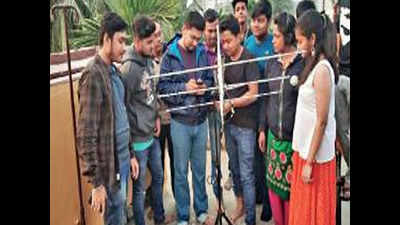- News
- City News
- kolkata News
- Signal from International Space Station spices up Sunday afternoon for radio operator students
Trending
This story is from January 23, 2019
Signal from International Space Station spices up Sunday afternoon for radio operator students

Students work with the custom-built antenna that picked up the ISS.
KOLKATA: The International Space Station (ISS) remains an enigma to most people across the world. No wonder, it came as a pleasant surprise for a group of students — at West Bengal Radio Club’s (WBRC) Sodepur facility — when they picked up a signal beamed by the ISS on Sunday afternoon while learning the basics of radio communication with hand-held radio sets and a custom-built antenna.

WBRC secretary Ambarish Nag Biswas said, “The students were thrilled.It was a clear day and we could spot the ISS as it orbited the earth. The exercise for the day was to learn how to communicate using 5 Watt hand-held sets during an emergency. Amateur radio operators travel regularly to disaster zones to provide backup and assistance to civil or military authorities. At times, they are unable to carry large radio sets to remote parts. There have been instances when some operators got stranded with nothing but hand-held sets. In such situations, there is no way to get in touch with others as the range of such sets is usually 8-10km.”
 Signal at the training session on Sunday.
Signal at the training session on Sunday.
“A radio operator in distress with a hand-held radio set can use a satellite to get in touch with others and relay his/her location. During the training that involved students from several schools and colleges, we picked up a signal. On checking, we realized that its origin was the ISS. The students were thrilled,” Nag Biswas said.
“This was an unexpected bonus. Many of them said that they would like to open radio clubs at their schools and colleges and. Our intention is to get more people to take up amateur radio as a hobby and help during disasters such as cyclones and earthquakes,” he added.
Some of the younger students looked up the internet to learn more about ISS and its present occupants. Their interest was peaked when they found that Indian Space Research Organisation (ISRO) was likely to send the first Indian to space in an indigenous craft in 2021-22.
Special permission is required from Nasa to communicate with astronauts on the ISS, for which WBRC has written to the American space agency.

WBRC secretary Ambarish Nag Biswas said, “The students were thrilled.It was a clear day and we could spot the ISS as it orbited the earth. The exercise for the day was to learn how to communicate using 5 Watt hand-held sets during an emergency. Amateur radio operators travel regularly to disaster zones to provide backup and assistance to civil or military authorities. At times, they are unable to carry large radio sets to remote parts. There have been instances when some operators got stranded with nothing but hand-held sets. In such situations, there is no way to get in touch with others as the range of such sets is usually 8-10km.”

While many of the students haven’t received radio licences yet, engineering students — Jayanta Baidya and Gaurav Paul — were demonstrating the use of the antenna in communication through satellites. The others could only listen in. There are some satellites that amateur radio buffs are allowed to use. Using the antenna, the students were shown how communication was possible not only across the country but even across the globe.
“A radio operator in distress with a hand-held radio set can use a satellite to get in touch with others and relay his/her location. During the training that involved students from several schools and colleges, we picked up a signal. On checking, we realized that its origin was the ISS. The students were thrilled,” Nag Biswas said.
“This was an unexpected bonus. Many of them said that they would like to open radio clubs at their schools and colleges and. Our intention is to get more people to take up amateur radio as a hobby and help during disasters such as cyclones and earthquakes,” he added.
Some of the younger students looked up the internet to learn more about ISS and its present occupants. Their interest was peaked when they found that Indian Space Research Organisation (ISRO) was likely to send the first Indian to space in an indigenous craft in 2021-22.
Special permission is required from Nasa to communicate with astronauts on the ISS, for which WBRC has written to the American space agency.
End of Article
FOLLOW US ON SOCIAL MEDIA










